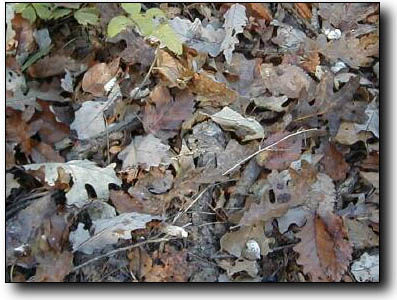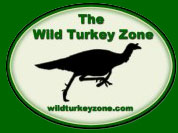|
Fall
Hunting Techniques
 |
|
Droppings
Under a Gobbler's Roost
|
Fall turkey hunting can
be just as exciting as spring. Having a flock
of jakes stampeding into your fighting purrs
will get the heart pumping as much as a close
range strutting spring gobbler. Fall is a very
busy time for most hunters and fall turkey hunting
often takes a back seat to deer, waterfowl and
upland hunting. What does this mean? Well, often
you will have the woods to yourself if you're
a dedicated fall turkey hunter. This is good
for many reasons but perhaps most importantly
it gives you plenty of time for fall hunting
which is necessary if you're planning on taking
a fall gobbler. Which brings us to the most
important aspect of fall hunting, patience.
Patience, while important
in spring hunting, is at least twice as important
if you plan on hunting for a fall gobbler.
Busting up a flock of hens and poults and
calling them back in can sometimes be over
in a couple of minutes. Gobblers, however
are a completely different story altogether.
In the fall, gobblers could care less about
hens and are only somewhat inclined to flock
together with other gobblers. Fall gobblers
usually cannot be called in using hen yelps,
cutts or cackles. Instead, you have to sound
like a gobbler to call in a gobbler in the
fall. This means using low clucks, gobbler
yelps, fighting purrs and even gobbles to
attract a fall tom.
The techniques consistent
from spring to fall are good scouting, woodsmanship
and correct calling. I've found the most important
part of fall turkey hunting is spending a
lot of time scouting birds. If you can find
a flock of either hens & poults or gobblers
and pattern their movements, it's much easier
to succeed using any of the fall techniques.
It's always easier to call a turkey to a location
he wants to go to anyway.
Let's say you
have a flock of turkeys located. Now, how
do you hunt these birds? Generally, fall hunting
techniques include:
Scatter
and call back-
The most popular method for hunting
fall turkeys is to scatter a drove and try to
call individual turkeys back. The idea is to
scout out and get as close as possible to a
flock of turkeys and then run towards them yelling
and whooping to try and get them to break up
as much as possible. Running with a loaded gun
is never a good idea so put down your gun and
run like a mad man at the flock. I've heard
barking like a dog can help scatter them better.
I've never tried this I guess because of the
fear someone not familiar with fall turkey hunting
would see me and assume I was crazy. One warning
though, know your terrain before you take off
running. The first time I tried busting a flock
in the fall, I was walking the top of a steep
ridge when I saw a flock out in front of me.
I ran screaming and waving my arms at the flock.
Everything was going good until I stepped on
a round rock and took a spill. I eventually
ended up about 30 feet below on the edge of
the creek. Evidently, cursing while tumbling
down a rocky slope is not a good scatter technique
since I had no luck calling in these turkeys.
Ideally, the flock will scatter
in all directions or at least split up in
two groups because this will give you the
best opportunity to call them back to the
flush site. Hopefully, there are a lot of
lonely turkeys after the scatter but many
times they do not scatter well at all. If
they all fly off together your only real choice
is to try and scatter them again.
Terrain can be
a big factor here as well. I do most of my
turkey hunting in Kansas and our typical terrain
doesn't have mile after mile of woods. I am
usually hunting a fairly narrow strip of woods
either along a wooded gulley or a single ridge
along a creek bottom. Trying to scatter turkeys
in a 50 yard strip of trees can be very trying
because the birds will generally just go in
one bunch and it will take multiple scatters
to finally get some turkeys separated. One
good tactic to help you out here is to scatter
from both sides with a hunting partner. By
coming in from both directions, the turkeys
are more likely to get a good scatter.
If the turkeys
seem to scatter fairly well but all go in
the same general direction, walk 100 to 200
yards in that direction before you set up
to begin calling. Sometimes you will not get
a good scatter and the turkeys will re-flock
immediately before you have a chance to call
in any loners.
There are several
other variations to the scatter technique
which can be even more successful. If possible,
get out the evening before the hunt and locate
a flock going up to roost. Wait until it's
good and dark and then go underneath their
roost tree(s) and start yelling and banging
on the trees with a dead limb to make the
branches shake. If there are vines hanging
from the tree, shake them also and wave your
flashlight around. This should scatter them
really well and they will not regroup until
the next morning when it is light. The next
morning, get to the roost site early to get
in the middle of the regrouping flock.
Some people say
to wait 30 to 45 minutes after the flush to
start calling and that is probably true for
a gobbler flock especially. However, typically
you find a flock of hens and poults and the
poults will often start calling immediately
after the flush. You'll just have to play
it by ear most of the time. As soon as you
hear some other turkeys start calling, you
better begin yourself. One of the best tactics
is to just repeat the call you hear. If a
young turkey starts kee-keeing give him one
right back. If you hear hen yelps, yelp right
back at her because you don't want her out-calling
you and getting the flock to come to her.
Many times if the old boss hen is close to
you and begins calling, it is best to just
get up and scare her away.
If you do happen
to find a flock of fall gobblers and try this
technique, you better have a lot of patience.
Gobblers are not really social in the fall
and when scattered it may take them anywhere
from a few hours to a few days to get back
together. If you want to call in a gobbler
in the fall, you have to learn to talk like
one. Gobblers have no interest in hens at
this time of the year so they will no respond
to hen yelps or clucks. You'll need to learn
to make gobbler yelps and clucks which generally
are harsher and deeper sounding and also are
slower paced than hen calls.
Turkey
Dogs -
Another tactic
used by many to get good scatters is a turkey
dog. These dogs can find and then flush a
flock of turkeys and then sometimes flush
them again to get them really scattered. The
dogs are taught to stop and bay at the flush
site to allow the hunter to catch up and constrain
the dog before beginning calling. Generally,
these dogs are Boykin Spaniels but some other
breeds have been trained to do the same thing.
For more Info on turkey dogs
see - Turkey
Dog News
Intercept
and Call-
Many people prefer
to try and call in the whole turkey flock
instead of scattering them. This is the general
method I prefer to always try first. If I
cannot call the flock in I will then try and
scatter them and try to call in an individual
bird. My feelings are if you have turkeys
close to you, why not try and call them in
as a group before spooking them. It works
well some of the time and gives you two chances
for success.
Locating a flock
of turkeys can be done by either viewing a
flock and maneuvering to get closer or by
using your ears and finding a flock scratching
or calling amongst themselves. Once you have
a flock located, try and judge where they
are traveling and get in front of them before
setting up. Start out by giving a few yelps
or clucks. If you get a response copy that
turkey's call.
Another good tactic in this
situation is to use a fighting purr. All turkeys,
especially young ones, are really active fighting
in the fall and they love to come running
when they hear a fight going on. Turkeys are
constantly fighting in the fall as they try
and establish the flock's pecking order. They
make a lot of noise when they fight so I do
too when I'm trying to call them in. I've
had the best luck while hunting with a buddy
and having both of us calling like crazy.
It's also a good idea to use a wing or hat
to beat on the ground or trees around you.
A turkey fight is loud with lots of wingbeats,
purring, cutts and clucks and more. If you
can get close to copying all of these sounds,
you will sound more realistic and be more
effective. Getting charged by a group of 20
young jakes in the fall can be a lot more
intense than even calling in an old longbeard
in the spring.
Random
Calling-
If you cannot
locate a drove or flock of turkeys, it is
possible to just move around in areas known
to have turkeys and call like in the spring
to try and get turkeys to respond. Once again,
start out by giving a few yelps or clucks.
If you get a response copy that turkey's call.
Lost calls work well in this situation also.
Still
Hunting and Stalking-
Truth be known,
there are a lot more turkeys killed in the
fall by deer hunters sitting in their stands
than most people think. Many deer bowhunters
will also buy a turkey tag just in case a
flock of turkeys wanders by their stand. Other
hunters that go after turkeys exclusively
and scout out a particular bunch of birds
to pursue will also use the still hunting
technique. If you can pattern a flock and
find out when and where they enter a feed
field, cross a creek or river, or travel to
and from their roost, sitting in a blind near
their path can be the most effective hunting
tactic of all. It may not bring the satisfaction
of calling a bird in but if you are looking
for a Thanksgiving bird, it may not matter
to you at all.
Whatever technique you choose,
killing a mature longbeard in the fall is
no simple task.
|

